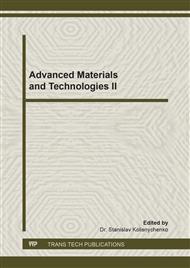[1]
Antiohos S, Maganari K, Tsimas S. Evaluation of blends of high and low calcium fly ashes for use as supplementary cementing materials. Cement Concrete Composite 2005; 2:349–56.
DOI: 10.1016/j.cemconcomp.2004.05.001
Google Scholar
[2]
Raheem AA, Kareem MA. Optimal raw material mix for the production of rice husk ash blended cement. Int. J. Sustain. Constr. Eng. Technol. 2017; 7(2): 77–93.
Google Scholar
[3]
Adesanya DA, Raheem AA. Study of the Workability and Compressive Strength Characteristics of Corn Cob Ash Blended Cement Concrete, Construction and Building Materials Journal 2009; 23: 311-317.
DOI: 10.1016/j.conbuildmat.2007.12.004
Google Scholar
[4]
Adesanya DA, Raheem AA. A Study of the Permeability and acid attack of Corn Cob Ash Blended Cement Concrete, Construction and Building Materials Journal 2010; 24: 403-409.
DOI: 10.1016/j.conbuildmat.2009.02.001
Google Scholar
[5]
Raheem AA, Olasunkanmi BS, Folorunso CS. Saw Dust Ash as Partial Replacement for Cement in Concrete. Organization, Technology and Management in Construction – An International Journal 2012; 4(2): 472-478.
DOI: 10.5592/otmcj.2012.2.3
Google Scholar
[6]
Raheem AA, Adenuga OA. Wood ash from bread bakery as partial replacement for cement in Concrete. International Journal of Sustainable Construction Engineering & Technology 2013; 4(1): 75-81.
Google Scholar
[7]
Raheem AA, Ige AI. Chemical composition and physicomechanical characteristics of sawdust ash blended cement 2019; 21: 404-408.
DOI: 10.1016/j.jobe.2018.10.014
Google Scholar
[8]
Raheem AA, Orogbade BO. Characteristics of blended cement produced from selected hardwood ashes, FUOYE Journal of Engineering and Technology, 2018; 3(1): 61-66.
DOI: 10.46792/fuoyejet.v3i1.156
Google Scholar
[9]
Siddique R. Utilization of wood ash in concrete manufacturing. Resources, Conservation and Recycling 2012; 67: 27-33.
DOI: 10.1016/j.resconrec.2012.07.004
Google Scholar
[10]
Abdullahi M. Characteristics of Wood Ash/OPC Concrete. Leonardo Electronic Journal of Practices and Technologies 2006; 5 (8): 9 - 16.
Google Scholar
[11]
Udoeyo FF, Inyang H, Young DT, Oparadu EE. Potential of wood waste ash as an additive in concrete. Journal of Materials in Civil Engineering 2006; 18(4): 605-11.
DOI: 10.1061/(asce)0899-1561(2006)18:4(605)
Google Scholar
[12]
Chowdhury S, Maniar A, Suganya OM. Strength development in concrete with wood ash blended cement and use of soft computing models to predict strength parameters. Journal of Advanced Research 2015; 6: 907 - 913.
DOI: 10.1016/j.jare.2014.08.006
Google Scholar
[13]
Sikora P, Cendrowski K, Horzczaruk E, Mijowska E.The effects of Fe3O4 and Fe3O4/SiO2 nanoparticles on the mechanical properties of cement mortars exposed to elevated temperatures. Construction and Building 2018; 182: 441-450.
DOI: 10.1016/j.conbuildmat.2018.06.133
Google Scholar
[14]
Mahender B, Ashok R. Effect of Nanosilica on the Compressive Strength of Concrete. International Journal of Professional Engineering Studies 2017; 8(2): 222-226.
Google Scholar
[15]
Berra M, Carassiti F, Mangialardi T, Paolini AE, Sebastiani M. Effects of nanosilica addition on workability and compressive strength of Portland cement pastes. Construction and Building Materials 2012; 35: 666-675.
DOI: 10.1016/j.conbuildmat.2012.04.132
Google Scholar
[16]
Nazari A, Riahi S. The effects of TiO2 nanoparticles in flexural damage of self-compacting concrete. International Journal of Damage Mechanism 2011a; 20: 2049-2072.
DOI: 10.1177/1056789510385262
Google Scholar
[17]
Nazari A, Riahi S. Improvement compressive strength of concrete in different curing media by Al2O3 nanoparticle. Material Science and Engineering A 2011b; 528: 1183 – 1191.
DOI: 10.1016/j.msea.2010.09.098
Google Scholar
[18]
Nazari A, Riahi S. The effects of SiO2 nanoparticles on physical and mechanical properties of high strength compacting concrete. Composites: Part B 2011c; 42: 570-578.
DOI: 10.1016/j.compositesb.2010.09.025
Google Scholar
[19]
BS 1881: Part 102-83. Method for determination of slump. London, British standard institution, (1983).
Google Scholar
[20]
BS 1881: Part 103-83. Method for determination of compacting factor. London, British standard institution, (1983).
Google Scholar
[21]
ASTM C 618-9. Standard specification for fly ash and raw or calcined natural pozzolan for use as mineral admixture in Portland cement concrete. Annual book of ASTM Standards, Philadelphia, USA, ASTM, (1991).
DOI: 10.1520/c0618-00
Google Scholar
[22]
Jerath S, Hanson N. Effect of fly ash content and aggregate gradation on the durability of concrete pavement. Journals of Material in Civil Engineering 2007; 19(5): 367-375.
DOI: 10.1061/(asce)0899-1561(2007)19:5(367)
Google Scholar
[23]
Smith GN, Smith IGN. Elements of Soil Mechanics, 7th ed., Blackwell Science, London, (1998).
Google Scholar
[24]
Bowles JE. Engineering Properties of Soils and Their Measurements, 4th ed., New York, McGraw Hill, (1992).
Google Scholar
[25]
Lin K, Chang WC, Lin DF, Luo HL, Tsai MC. Effect of nanosilica and different ash particle sizes on sludge ash-cement mortar. Journal of Environmental Management 2008; 88: 708-714.
DOI: 10.1016/j.jenvman.2007.03.036
Google Scholar
[26]
Ghafari E, Costa H, Juilo E, Portugal A, Duraes L. The effect of nanosilica addition on flowability, strength and transport properties of ultra high performance concrete. Materials and Design 2014; 59: 1-9.
DOI: 10.1016/j.matdes.2014.02.051
Google Scholar
[27]
Chowdhury, S., Mishra M., Suganya O. M. The incorporation of wood waste ash as a partial cement replacement material for making structural grade concrete: An overview, Ain Shams Engineering Journal, 2015b, 6: 429-437.
DOI: 10.1016/j.asej.2014.11.005
Google Scholar
[28]
Saloma NA, Imran I, Abdullah M. Improvement of concrete durability by nanomaterials, Procedia Engineering 2015; 125: 608-612.
DOI: 10.1016/j.proeng.2015.11.078
Google Scholar
[29]
Mohamed, A. M. Influence of nona materials on flexural behavior and compressive strength of concrete, HBRC Journal, 2016; 12:212-225.
DOI: 10.1016/j.hbrcj.2014.11.006
Google Scholar


